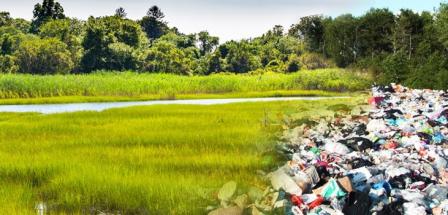Informational Webinar: PFAS in Landfills and Groundwater
Date and Time
Tuesday 09/05/2017 3:00PM to 4:00PM EDTLocation
Details

Informational Webinar
PFAS in Landfills and Groundwater
Date: Wednesday, Sept. 5, 2018
Time: 3:00 p.m. – 4:00 p.m.
Meeting Reschedule Notice: Due to technical difficulties with the sound during the webinar convened on Wednesday, Aug. 28, 2018 we are offering an additional webinar scheduled for Wednesday, September 5th, 2018.
Join us for this informational webinar discussing the application process and required elements for the Practical Methods to Analyze and Treat Emerging Contaminants (PFAS) in Solid Waste, Landfills, Wastewater/Leachates, Soils, and Groundwater to Protect Human Health and Environment Request for Applications (RFA).
The U.S. Environmental Protection Agency (EPA), as part of its Science to Achieve Results (STAR) program, is seeking applications proposing research that will lead to: (1) better understanding and characterization of the types and quantities of current and historical per- and poly-fluoroalkyl substances (PFAS) and PFAS-containing waste associated with waste disposal (e.g., landfills), as well as media containing PFAS released from these activities (e.g., PFAS in leachate collected by landfills or PFAS leaching to subsurface soils and groundwater); (2) increased knowledge of the fate, transport, potential for degradation or other changes to PFAS, and their mobility during materials management (e.g., under different landfill conditions such as pH, temperature, moisture content) that facilitate or retard such transformation or movement; and (3) new or improved methods that are more effective, efficient (in cost, energy, etc.), and practical in controlling, treating, destroying, or removing PFAS in waste and wastewater, landfill leachates, biosolids, or environmental media. The main goal is to promote innovation in evaluating and managing PFAS in solid waste, landfills, and environmental media that will lead to improved decision making, management practices, and technical methods to minimize the risks to both humans and ecosystems.
This informational webinar will review the RFA’s research interest and application and review process. Potential applicants interested in the funding opportunity will be able to ask questions from EPA experts.
Webinar Objectives
- Share General Information about the EPA STAR RFA, “Practical Methods to Analyze and Treat Emerging Contaminants (PFAS) in Solid Waste, Landfills, Wastewater/Leachates, Soils, and Groundwater to Protect Human Health and the Environment”
- Learn about the application process, eligibility and peer review processes
- Questions & Answer Session
RFA Research Areas & Questions (1) Better understanding and characterization of the types and quantities of current and historical PFAS and PFAS-containing waste associated with waste disposal (e.g., landfills), as well as media containing PFAS released from these activities (e.g., PFAS in leachate collected by landfills or PFAS leaching to subsurface soils and groundwater):
- What types and quantities of PFAS are released to the environment during waste management and how do the releases occur? What are the relative contributions of different types of waste and landfills to environmental PFAS? What are the characteristics of current wastes containing long-chain and short-chain PFAS, including PFAS from past and current chemical production and use (e.g., use in manufacturing processes, consumer goods, firefighting foam and other products), and PFAS-treated goods being disposed at their end-of-life, and other solid waste streams (e.g., waste incinerator ash)? What types and concentrations of PFAS are likely to be found in landfills? What are the potential ways to characterize PFAS in pre-landfill wastes and to treat PFAS-containing wastes before land disposal? Are there novel ways to characterize different PFAS leaching from the landfill under plausible landfill conditions? What are the most effective ways to characterize the PFAS from previously disposed wastes (as long as decades ago) found in landfills (e.g., MSW lined and abandoned unlined landfills as well as other RCRA nonhazardous waste landfills)? What are the types and concentrations of PFAS found in previously disposed waste and/or in leachate, contaminated soils and landfill gas? Is there a temporal signature in the waste that can be discerned from any degradation, transformation, or loss?
(2) Increased knowledge of the fate, transport, potential for degradation or other changes to PFAS, and their mobility during materials management (e.g., under different landfill conditions such as pH, temperature, moisture content) that facilitate or retard such transformation or movement:
- Are there more effective, practical, and efficient methods of evaluating the fate, transport, potential for degradation or other changes to PFAS, and their mobility in different types of landfills, soils, and subsurface environments, and environmental or other factors affecting the changes or movements? Are there novel, rapid, and cost-efficient analytical methods that will enable more confident and accurate analyses of PFAS in soil, leachate, groundwater and landfill gas? What are the main sorption/desorption reactions that govern the mobility of PFAS in landfills? Are there innovative technologies or methods (other than landfill liners) that can immobilize or otherwise prevent PFAS release from landfills into environmental media?
(3) New or improved methods that are more effective, efficient (in cost, energy, etc.), and practical in controlling, treating, destroying, or removing PFAS in waste and wastewater, landfill leachates, biosolids, or environmental media:
- What are the most effective and efficient chemical/biological/physical methods for treating solid waste, landfill leachate, wastewaters, biosolids, or contaminated environmental media to remove or destroy the PFAS? How can the methods be tested and validated in a bench- and pilot-scale? Are there new ways to bring synergies between leachate treatment and PFAS-contaminated groundwater potentially used for drinking water? How can the new methods be developed, tested, and validated so wastewater/leachate treatments that can also be used for treating groundwater potentially be used for drinking water?
Webinar Files:
- Practical Methods to Analyze and Treat Emerging Contaminants (PFAS) in Solid Waste, Landfills, Wastewater/Leachates, Soils, and Groundwater to Protect Human Health and the Environment (PDF)(15 pp, 494 K, 09/06/2018)
- Q&A's For PFAS in Landfills and Groundwater Webinar (PDF)(3 pp, 521 K, 9/7/2018)
